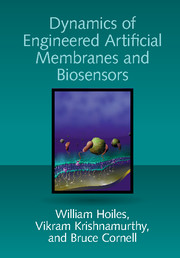Book contents
- Frontmatter
- Contents
- Preface
- List of Abbreviations
- Part I Introduction and Background
- Part II Building Engineered Membranes, Devices, and Experimental Results
- Part III Dynamic Models for Artificial Membranes: From Atoms to Device
- 8 Reaction-Rate-Constrained Models for Engineered Membranes
- 9 Reaction-Rate-Constrained Models for the ICS Biosensor
- 10 Diffusion-Constrained Continuum Models of Engineered Membranes
- 11 Electroporation Models in Engineered Artificial Membranes
- 12 Electroporation Measurements in Engineered Membranes
- 13 Electrophysiological Response of Ion Channels and Cells
- 14 Coarse-Grained Molecular Dynamics
- 15 All-Atom Molecular Dynamics Simulation Models
- 16 Closing Summary for Part III: From Atoms to Device
- Appendices
- Bibliography
- Index
11 - Electroporation Models in Engineered Artificial Membranes
from Part III - Dynamic Models for Artificial Membranes: From Atoms to Device
Published online by Cambridge University Press: 25 May 2018
- Frontmatter
- Contents
- Preface
- List of Abbreviations
- Part I Introduction and Background
- Part II Building Engineered Membranes, Devices, and Experimental Results
- Part III Dynamic Models for Artificial Membranes: From Atoms to Device
- 8 Reaction-Rate-Constrained Models for Engineered Membranes
- 9 Reaction-Rate-Constrained Models for the ICS Biosensor
- 10 Diffusion-Constrained Continuum Models of Engineered Membranes
- 11 Electroporation Models in Engineered Artificial Membranes
- 12 Electroporation Measurements in Engineered Membranes
- 13 Electrophysiological Response of Ion Channels and Cells
- 14 Coarse-Grained Molecular Dynamics
- 15 All-Atom Molecular Dynamics Simulation Models
- 16 Closing Summary for Part III: From Atoms to Device
- Appendices
- Bibliography
- Index
Summary
Introduction
A lipid membrane that contains negligible defects and no ion channels will not allow ions to pass through the membrane. Indeed a membrane can be viewed as an electric capacitor. However, if an excitation is applied to the membrane this will cause the temporary breakdown of the membrane, causing water-filled pores to form that are large enough to allow the passage of ions and molecules through the membrane – this process is called electroporation.
Electroporation is the process of aqueous pore formation in biological membranes when a voltage potential (e.g., ion gradient) is applied across the membrane. Several microbiology techniques are based on the use of electroporation to increase the permeability of the cell membrane to allow the passage of macromolecules, drugs, DNA, and antimicrobial peptides into the cell. These microbiology techniques are focused on how to design the excitation potential to allow the passage of these molecules through the membrane while ensuring the membrane is not irreversibly damaged. In this chapter we construct mesoscopic diffusion models of electroporation in engineered tethered membranes. The formulation in this chapter relies heavily on the Smoluchowski–Einstein equation, which is a probabilistic model for the number of aqueous pores formed. Additionally, we use statistical mechanics and electrodiffusive dynamic models to estimate lumped circuit parameters such as membrane conductance, membrane capacitance, and double-layer capacitance in the presence of electroporation. Recall that Chapters 4 and 6 dealt with the construction and experimental measurement methods for the electroporation measurement platform. Put simply, this chapter gives mathematical models and associated insight at the mesoscopic level to explain the experimental results of Chapter 6.
Applications of Electroporation
Electroporation has been used in a variety of in vitro and in vivo biotechnical applications for antitumor treatment, protein insertion, cell fusion, and gene and drug delivery.
The process of electroporation results in the formation of pores in the membrane that allow molecules and ions to pass through the hydrophobic bilayer membrane. During electroporation the lipid molecules remain intact; they merely undergo a collective configurational change to form nanometer-sized aqueous pores. These aqueous pores allow ions and molecules to pass through the membrane. There are two types of electroporation:
Reversible electroporation. Reversible electroporation occurs if, after the excitation potential is removed, the lipids can rearrange to form an impermeable membrane.
- Type
- Chapter
- Information
- Dynamics of Engineered Artificial Membranes and Biosensors , pp. 212 - 249Publisher: Cambridge University PressPrint publication year: 2018



